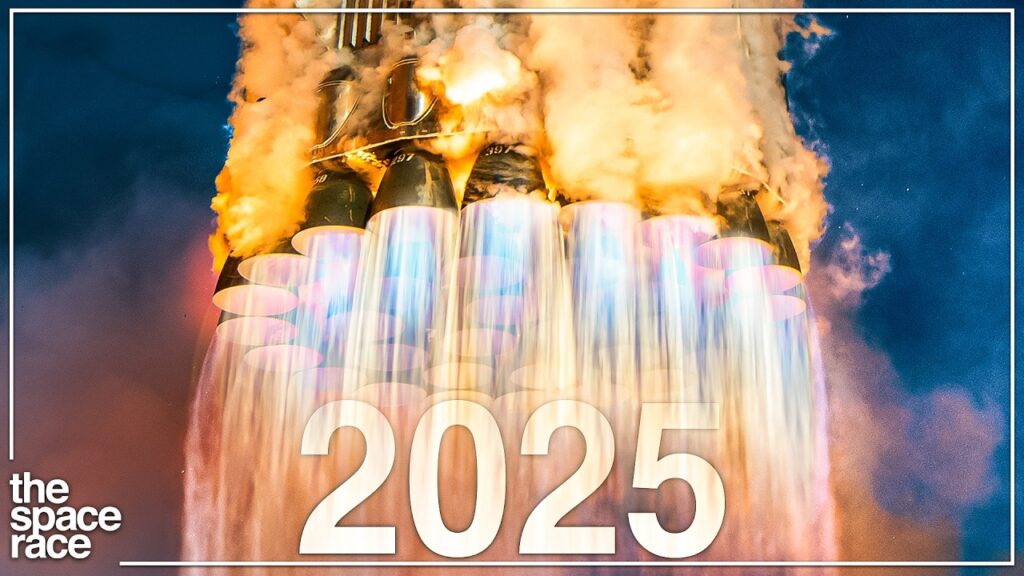Space exploration in 2025 is set to be an exciting year, with major milestones coming from SpaceX, Blue Origin, and China’s space industry. From Starship’s next groundbreaking test flight to Blue Origin’s long-awaited New Glenn rocket and China’s quest for reusable rockets, the space race is heating up.
Let’s dive into what’s coming up in the world of space exploration!
SpaceX’s Starship Block 2: A Major Leap Toward Active Duty
SpaceX is about to achieve something unprecedented with its Starship rocket. This weekend marks the seventh test flight of the vehicle, and it’s going to be a pivotal moment in the transition of Starship from a testing phase to active duty. During this test, SpaceX will deploy a payload into space for the very first time.
Starship will carry 10 Starlink simulators—mock versions of the company’s new V3 communication satellites. The V3 satellites are notably heavier than their predecessors, weighing just under 2 metric tons (2,000 kg), compared to the previous Starlink V2 mini’s 0.5 tons. This move highlights the increasing payload capabilities of Starship. When fully operational, Starship is expected to carry as many as 54 V3 satellites in a single launch, which would equate to over 100 metric tons of payload capacity!
The 10 simulators will be deployed through a new mechanism known as the “Pez dispenser,” which pushes the payload out of a slot in Starship’s body. This marks another critical step for SpaceX in preparing for larger payload deployments, even though this test will be a suborbital flight. After the payload deployment, Starship and its cargo will fall back to Earth, splashing down in the Indian Ocean near Australia.
Major Upgrades for Starship Block 2
SpaceX has also revealed exciting upgrades to Starship’s Block 2 design. Key changes include:
- Smaller, improved nose flaps: Designed for better aerodynamics and more efficient re-entry.
- Increased propellant volume: The Block 2 Starship is longer and accommodates 25% more propellant, making it ready for larger payloads.
- Active cooling heat shield tiles: These will be tested in the upcoming flight, a technology that Elon Musk had previously hinted at. The heat shield will incorporate a liquid-cooled stainless-steel sandwich, designed to cool the windward side of the rocket during re-entry. This system is similar to the one used in the Starship’s showerhead flame diverter and could replace the existing ceramic heat shield tiles if successful.
- Vacuum-jacketed fuel lines: This innovation will help keep Starship’s fuel at the optimal temperature, reducing heat transfer and increasing propulsion efficiency.
- Powerful flight computer: A new, more advanced flight computer will control 24 high-voltage actuators and 30 onboard cameras. Expect amazing views from this mission, thanks to Starlink’s high-speed data transmission.
- Reused Raptor engine: For the first time, a previously flown Raptor engine will be used on Starship’s booster, demonstrating SpaceX’s growing focus on reusability.
SpaceX’s advancements in technology and reusability continue to set the bar high for future space exploration.
Blue Origin’s New Glenn: A New Era for America’s Largest Rocket
Blue Origin is finally ready to launch its New Glenn rocket after years of development. On December 27, 2024, Blue Origin completed a crucial 24-second hot fire test of New Glenn’s seven engines. The next step? A potential launch window opening as early as January 2025 at Cape Canaveral Space Force Station.
At 320 feet tall and 7 meters wide, New Glenn is significantly larger than other rockets in service today, though still smaller than SpaceX’s Starship. The rocket will be aiming for a reusable booster landing, similar to SpaceX’s Falcon 9. If successful, this would be a huge achievement for Blue Origin and the space industry in general.
The first New Glenn flight will carry a mass simulator representing the Blue Ring spacecraft, a precursor to future Blue Origin missions. The demonstration will test critical systems, including communications, power, and navigation, and could pave the way for Blue Origin to secure contracts for U.S. national security payloads. This will be a milestone for Blue Origin’s future missions, and we can’t wait to see if they can stick the landing.
China’s Space Program: The Long March Toward Reusability
China is making significant strides in space technology, particularly with its Long March family of rockets. In 2025, China will see the launch of two upgraded rockets:
- Long March 8A: This new version of the Long March 8 will feature a larger cargo fairing and a boost in payload capacity, allowing for deployments of up to 7 metric tons to a sun-synchronous orbit (SSO) of 700 km.
- Long March 12A: This is China’s first attempt at a reusable rocket booster. The rocket will attempt a vertical landing after reaching an altitude just below space (75 km). This marks a significant milestone for China’s space ambitions, as the country races to develop reusable rockets similar to SpaceX’s Falcon 9.
In addition to state-backed projects, China’s commercial space companies are also pushing the envelope. LandSpace is preparing its ZK-3 rocket for its first orbital flight, aiming to compete with SpaceX’s Falcon 9 in payload capacity. Similarly, Pioneer Space is gearing up for another attempt with its Tian Long 3 rocket, despite the dramatic failure of a previous static fire test.
These advancements from China’s space sector signal that the country is catching up to global space leaders, and 2025 could be a breakthrough year for Chinese space technology.
The Exciting Future of Space Exploration in 2025
As we look ahead to 2025, there’s a lot to be excited about in the world of space exploration. SpaceX, Blue Origin, and China are all making significant strides, and the year promises to bring new rockets, innovative technology, and dramatic milestones in the race to explore and utilize space. Whether it’s SpaceX’s Starship pushing the boundaries of reusable rockets, Blue Origin’s New Glenn preparing for its first launch, or China’s leap toward reusable boosters, the competition and collaboration in space will undoubtedly make for an action-packed year.
Read More:

